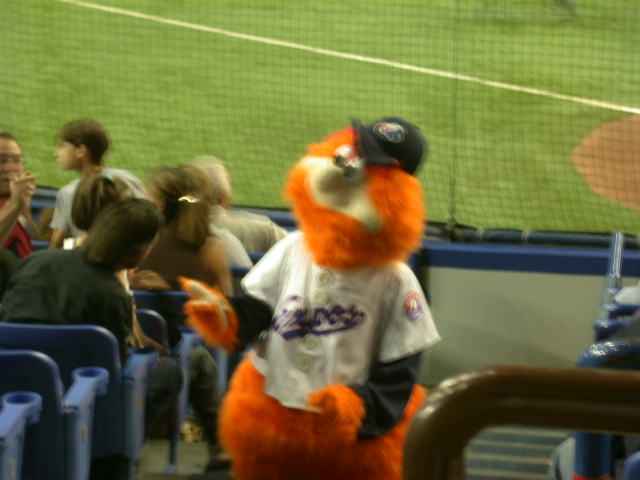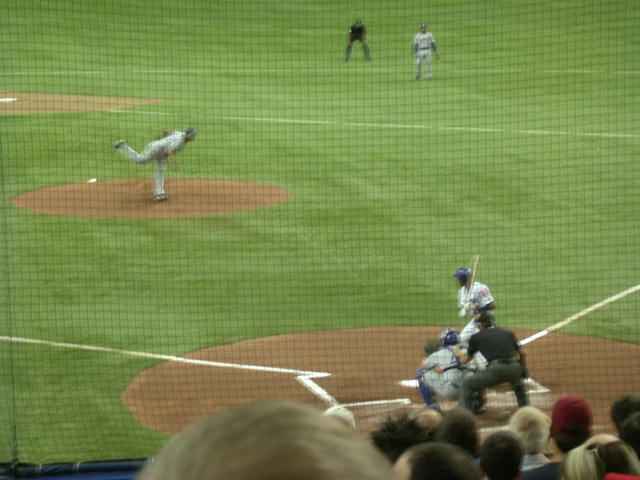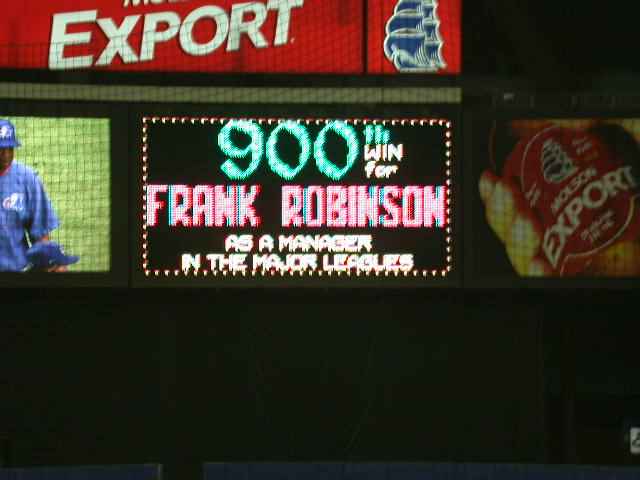One of my favorite of the games played by Rob Neyer in his column is comparing unnamed Player A with unnamed Player B.
Today, we’re going to play that game–but I’ll make it easier for you. Player A is Barry Lamar Bonds.
Barry Bonds so far this season:
HR BB BA OBP SLG
10 44 .463 .704 1.111
Player B so far this season:
HR BB BA OBP SLG
14 55 .216 .268 .308
Sure, Player B’s counting numbers are impressive–but the discrepancy between the huge number of walks and home runs and the low on-base percentage and slugging percentage surely have tipped you off that I’m being intentionally misleading.
Player B is not a single player. It’s the Montreal Expos. They’ve needed 903 plate appearances to compile those numbers.
Barry Bonds has needed only 98.
Barring injury, he’s going to break his own record of 198 walks. While doing that, he’s going to pass Rickey Henderson for most walks all-time. He’s going to break his own intentional walk record of 64.
And I’ll say it on the record: he’s going to hit .400.
Baggarly, I hope the circus of a .400 season will help compensate for boredom of covering the suprising wreckage of the Giants team in general. We’re watching Babe Ruth here, only far, far more impressive in context. I don’t expect ever to see his like again. We should watch him every chance we get.
Original comments…
Steve: Far more impressive than Babe Ruth?!??! This is a joke right? Let’s start with the obvious… 154 game season and only eight teams (that’s right eight) in the AL. No one will ever convince me that the overall quality of the players was not better in those days. 97mph fastball or no, back in the 30s Farnsworth is running a drill press….
Now for some less tangible but no less important factors that contribute to Bonds’ success. First, if I wear enough body armor to win a walk on part in Lord of the Rings, I’d feel pretty good about standing on the plate too. Oh for a spunky manager to tell his pitcher to back Bonds off the plate. You think the managers and pitchers of yore would give two shits about Bonds superstar status? They’d pitch him inside until he backed up or suffered a season ending hand injury…oh wait. Still, I can’t wait to see Clemens pitch to Bonds this year.
Back to the point– between a juiced baseball and a juiced player that 73 will have an asterisk next to it some day. From 49 to 73 is very Brady Anderson-esque. Sure, Babe Ruth was on the sauce and he had a little more protection in the lineup but his OBP and his slugging % are still better than Bonds. Bonds is one of the best players of all time and he is deserving of accolades but has too many negatives to be worthy of all the hyperbole you like to shower him with.
Levi: Leaving aside the steroids question, since there’s no definite evidence against Bonds, and leaving aside the juiced ball question, since test after test has been done of the ball and found little to no difference between balls of today and balls of previous years (Even in the weird power year of 1987, there was no difference.), here are the important points I think are in Bonds’s favor in an argument against Ruth:
1) Ruth never had to face black players. This is, clearly, a biggie. As a pitcher, he never would have had to face Bonds. As a hitter, he never would have had to face a pitcher like Bob Gibson or a fielder like Ozzie Smith.
2) Ruth never had to face Latin or Asian players. He never had to hit against a Pedro Martinez or Byung-Hung Kim or Hideo Nomo.
3) Ruth had less travel, fewer places. Yes, it was by train, so the trips were longer, but he was only having to travel in the Northeast. That’s got to be easier.
4) The number of ballplayers has grown, certainly, but the growth–even if you add in athletes stolen away by other sports–hasn’t come close to keeping up with the increase in the U.S. population in that period. Add in the worldwide scouting that teams do now, and we have far, far more than four times as many people available from which to cull not quite four times as many ballplayers.
4) Ruth never had to face ace relievers, working fully rested. Instead, because starters threw complete games, he got to face tired starters far more often than does Bonds. Starters were probably less tired in the ninth than they are now, because they’re more used to pitching far into the game and because–as interviews with old-time pitchers will tell you–they, for the most part, didn’t have to work as hard as starters today. They state clearly that they didn’t have to be at full intensity on every pitch. Now, when a garden-variety shortstop is strong enough to tie a game with one swing, pitchers are forced to concentrate more closely on every single pitch, and that wears out a pitcher more. Still, that doesn’t compensate for the difference between even a good starter in the 9th and a rested Billy Wagner or John Smoltz who’s able to throw as hard as possible, knowing he only has to throw twenty pitches or so.
5) Ruth didn’t play many night games. It’s generally acknowledged that hitting at night is a bit more difficult than hitting in full daylight.
6) Ruth played half his games in a ballpark that is very favorable to left-handed hitters. Bonds plays half his games in one of the hardest parks for any hitter in the majors. Ruth, in general, played on the road in bigger parks than Bonds, did, to be fair.
7) Pitchers facing Ruth didn’t have the wealth of information available that pitchers facing Bonds have. Pitchers facing Bonds can, if they want, quickly watch every atbat he’s had this year. The converse is true, of course: Ruth couldn’t scout pitchers in advance the way Bonds can. But, given Ruth’s character and reputation as not the hardest worker, can you see him doing much of that?
8) True, Ruth didn’t have body armor. And the thing Bonds wears on his elbow is absurd and should be stopped by the league–it’s over the top. But at least a few other players employ equally absurd devices (Craig Biggio, for example), yet they don’t seem to get the same results, or even anywhere near the same results.
9) Stephen Jay Gould’s best writing about baseball was about the disappearance of the .400 hitter. I can’t remember now which book it was in, but he argued that baseball, as a fairly consistent system (no insane rules changes), shows the characteristics of any system over time: variation decreases, and things settle around a norm, with far fewer extreme outliers. He buttressed his argument with evidence like the decrease in the number of absurdly good or absurdly bad teams, the decrease in the number of hitters who stood head and shoulders above or below the league, and the same with pitchers. I can’t do his argument justice right here, but it was convincing, and the conclusion was that achievements remarkably greater (or worse–see 2003 Detroit Tigers) than everyone else are far more difficult these days than they used to be.
That’s just off the top of my head, but I think that’s quite a few points directly in Bonds’s favor. The only true advantages that Bonds has that Ruth didn’t are the smaller road parks (an advantage that disappears if you look, as you should, at the relationship of the achievement to the league norms) and the tremendous advances in our understanding of nutrition and physical fitness since Ruth’s time. I’ve read about Bonds’s workout regimen. It’s insane. Other players who’ve tried it for even a few days have dropped out, exhausted. Maybe Ruth would have adhered to a similar regimen if he were to play today; he sure wasn’t known for taking care of himself, but you really never know what such an amazingly talented person would do under different circumstances.
The real question is, is what Bonds is doing, relative to the league, as impressive as what Ruth did, relative to his league? On the face of it, it’s clearly not. The year Ruth hit 54 homers, only two other _teams_ even had that many. But I think all the arugments you’re making, Steve, when really looked at, turn around and support Bonds. Maybe they don’t entirely close the gap–Ruth was an unbelievable player, and I would love to have seen him hit–but I think they clearly make the comparison worth thinking about. And if Bonds finishes the year with numbers even remotely like this–at age 41–I’ll be serious that he’s better than Ruth.
Levi: Oh, and a couple of other things:
1) While advanced nutrition techniques and physical fitness regimes have benefitted hitters much more than pitchers, they have benefitted pitchers (and fielders) some, too. The fielders today are almost certainly better than in the old days, on average, for reasons ranging from the established fact that people in developed countries are faster, quicker, bigger, and stronger than they were 75 years ago to the better and larger gloves fielders use. Even such a great play as Willie Mays’s catch of Vic Wertz’s line drive in the 1954 World Series doesn’t look _that_ impressive these days. I really believe I’ve seen plays just as good, by guys who aren’t even that well known for their fielding.
2) One advantage Bonds has that Ruth didn’t, but would definitely have made use of: thin-handled, scoop-ended bats. The understanding of the physics of bat speed has been crucial to the increase in power in the past decades. Look at the bats on ESPN Classic even in the 1980s. They’re giant and unwieldy.
3) Ruth, too, played most of his hitting career in a high-offense era. He largely created that era with his understanding of how to hit, and he stood head and shoulders above it, but he did benefit from other changes that other hitters benefitted from, too, like the introduction of a truly livelier ball and the more frequent substitution of new balls into play (following the death of Ray Chapman on a pitch where he didn’t seem to see the dirty, beat-up baseball at all).
4) The bit about 49 homers to 73 is, I assume, a steroids reference. Again, I suppose it’s possible. But from what I’ve seen since Bonds began hitting more home runs, it’s been largely because he has become even more selective than he was as a younger player, he’s taking more of an uppercut swing, and his swing has shortened considerably since his younger days. The shortened swing could be argued as a reflection of the benefits of steroids, if it turns out he’s on them, and you could even say his selectivity would benefit from the quicker hands and wrists that steroid-assisted strength might add. But in the absence of evidence, I’ll stay with the argument that Bonds decided, following Sosa/McGwire in 1998, to hit more home runs, and he adjusted his swing and approach accordingly.
Levi: Re-reading my post, I agree that I shouldn’t have said “far, far more impressive.”
I think it’s more impressive, but the emphatic additions were probably too much.
Steve: We’ll continue this tomorrow. You have many good points, some of which I was going to deploy (especially the nutrition angle) As I sign off for the day however I want to start with this. I’m a little troubled by the subtle undertones of this statement….
1) Ruth never had to face black players. This is, clearly, a biggie. As a pitcher, he never would have had to face Bonds…..Ruth never had to face Latin or Asian players. He never had to hit against a Pedro Martinez or Byung-Hung Kim or Hideo Nomo.
I don’t really see what race has to do with it. I think the league was small enough that even though it segregated against many deserving players, this did very little to alter the overall talent pool. If there were players from different races in the league do you really think it would have made a noticable difference spread out over an entire career? Anyway, Bob Gibson would have backed Bonds off the plate, too.
A guy stood at the plate with a heavy-ass bat, hung over and sweating booze in his flannels and made it happen. It’s kind of like you and your little glove from intramurals. I’m surprised you ever caught anything with that. That you could do it 99% of the time made me respect your skills as a fielder. You didn’t need fancy equipment and to this subjective observer I would say that glove was even a handicap. You weren’t basket catching anything. You understood the fundamentals of how to catch a ball, rarely practiced but were ,daresay, a natural. That’s what I’m getting at stats or no (stats which I think still support my arguments) Bonds is a robot but Ruth was a giant. It’s like preferring Kraftwerk to Hank Williams or Woody Guthrie. Digital v analog. Cats v dogs. Two different things and we’ll get to the steroids tomorrow but I think you are being a little Scalia-esque with the level of proof you seem to require.
Levi: I agree with your assertion (and I am pleased by the compliment to my fielding. Go small gloves!): Ruth really did tower over the field. It’s indisputable.
The reason that the absence of black, Latino, or Asian players is important is not that they are black, Latino, or Asian: it’s that their absence means that the league was manifestly _not_ composed of the best available players, let alone the best available athletes. Maybe it was composed of most of the best available. Maybe even 80% or 90%. But there is no argument that can convince me that excluding 10-15% of the US population (let alone the world population) from consideration on grounds that have nothing to do with talent will result in a league with an overall talent level as high as the one we have now, where teams–for all the biases they’re still working with–are looking for the best baseball players, worldwide, with no other considerations.
It’s not about race, per se. It’s about cutting off a source of talent. What galls about it is that the exclusion was based on race, certainly, but for this argument, that’s not the important part of the point.
Steve: Well Levi, you may be on to something with your Bonds-fawning but more on that in a moment. Back to the steroid scandal, I am less willing to offer a benefit of the doubt than you. In a court of law one is innocent until proven guilty but in the court of public opinion I think there is more than enough circumstantial evidence to implicate Bonds through his close association with already indicted people.
I contend Bonds was juiced up and hit 73 primarily as a result of this. His previous career high HR was 49 the year before. You contend he dedicated himself to changing his game and powering the ball out of the stadium. The next year he only hit 46HR– why the drop off? First he played in 10 less games. One remarkable fact I have learned thanks to this discussion is that Bonds has never played 162 games in a season. He played in 143 the years before and after the 73HR. The year after Bonds hit 73 HR his IBB almost doubled, and he walked 21 more times (in 10 less games) Clearly I can’t make my case that Bonds was juiced based on statistical evidence. He is a remarkable player. Let’s run down some of your other points.
Regarding the segregation of baseball. Bonds does have the advantage of playing against the best players in the entire world. In a functional sense, one might argue that the integration of baseball MUST have led to league expansion because it could absorb better players. Still, baseball was integrated in 1947 and didn’t expand until 1962 (15 years) I still contend this is, at best, a wash. However, one argument that would support your point in a twisted sense is the way in which Latin players are essentially farmed. Back in Ruth’s day there weren’t baseball colonies gathering in countless youngsters and signing them to contracts when they are in there early teens. In that sense, the players may be of better quality because they’ve made an industry out of it.
As talk turns to league contraction it’s clear that many players in today’s game don’t belong on major league rosters. I would argue the nature of specialization is really there to protect the superstars. Middle relievers are the baseball equivalent of cannon fodder. They go out there and they soak up innings. They aren’t good enough to start and they aren’t good enough to close. If it weren’t for the fact that there are so many teams you might well have a league full of Curt Schillings ready to go the distance against the Bonds’ of the world. In terms of closers, there are certainly a few world-beaters, Gagne, Smoltz, Eck, Rivera. But for every one of those guys there’s a head case with a big heater. Maybe it’s just me but I think baseball has become much more of a psychological sport. Why is it that 32 teams don’t have 32 awesome closers? It’s because pitching in that context is much more mental than physical. I think 90% of hitters have a clear advantage when they are going up against a “closer” in the 90s
On your point about travel, you’ve certainly got me there but regarding day v night games the Giants play the second most amount of day games in baseball (or at least they used to). And, if you listen to the Cubs, playing baseball in the day is harder because you have less time to “adjust” ie. sleep off the hangover. The players of Ruth’s era worked hard, played harder and then went back to work.
The parks of the old days all had their quirks but in general were much bigger than the parks of today. Sure if you can hit the porch in Tiger Stadium you are not necessarily bad-ass but if you hit a ball to dead center in the Polo Grounds you better hope you and your 4-lb bat got every bit of it.
In context, Bonds stands head and shoulders above most of league but I think A-Rod or Manny Ramirez are probably as good as he is. Of course, the trick is to put together a career of these mind-boggling numbers. It is remarkable that Bonds seems to be improving with age. 73HR is a gaudy number but I honestly think it will be broken again. It won’t linger there for 30+ years like Maris. Again, compared to the rest of league, Ruth definitely stands out more than Bonds. It’s too bad Gould passed or we might beg him to turn his analysis to this question. Do you know anyone at Stats? Gould may have a point but I still say, more pitchers, smaller ballparks, better nutrition and better equipment make hitting less of an art than it was in the old days. Bonds has clearly reduced it to a science. He is the MJ of baseball. I would say Ruth is more like Wilt Chamberlain. And I still think he sets the standards by which other players must be judged.
I’ve enjoyed this lively debate and in the spirit of our baseball wagers of years past I have one for you (but it doesn’t involve fellatio) If Bonds hits .400 this year (based on the minimum number of plate appearances to qualify for the batting title) I will 1) concede your point that he is better than Ruth and 2) treat you and your wife to a baseball game at a minor league stadium of your choosing within a 90 mile radius of your home. I think that covers Schaumburg (big whoop), Kane County, Gary, Joliet, Beloit and maybe another one that is slipping my mind. If Bonds fails to hit .400, I want 12 bottles of any (1) of these beers: PBR, Special Export or Old Style. Good luck.
Steve: Where’d the rest of my post go?
I can’t recreate it again but basically it said that I am right and you are wrong and in our tradition of talking ball, we need to put a wager on it (no fellatio involved)
If Bonds hits .400 based on enough plate appearances to qualify for the batting title I will…
1) Admit that Bonds is better than Ruth and, indeed, the best player of all time.
2) Host you and Stacey to a minor league ballgame within a 90-mile radius of your house. You can pick from such whistle stops as Schamburg, Cook County, Joliet, Kane County, Gary or Beloit.
If Bonds fails to hit .400 I want a 12pack bottles of either PBR or Special Export.
Today Bonds says he won’t hit .400 because he buys Levi’s argument that pitchers are just too good.
http://chicagosports.chicagotribune.com/sports/baseball/cs0405050295may05,1,5667075.story?coll=cs-baseball-print








